Design of three wheel recumbents
Author: Dipl.- Ing. W. Stiffel Im Holderbusch 7 D-76228 Karlsruhe Germany
To give an overview for newcomers, I tried to gather all design variations of three wheel recumbents and find a systematy. (remark: axle
pivot steering = Ackermann steering)
|
||||||||||||||||||||||
Two front wheels, front steering, rear wheel drive:
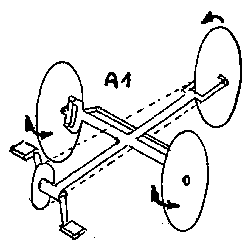
Comment:
Axle pivot steering
A1 popular Design: Leitra, Windcheetah, Vektor, Trice, 3R4, AnthroTech... In case of low seating height and large track: highest tilt resistance when braking in narrow curves. The axles of all wheels should join in one point (the same for B1, G1, H1, K1, L).
Two front wheels, front steering, rear wheel drive:
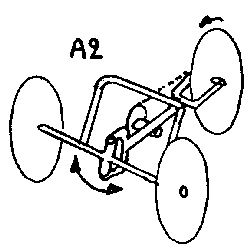
Comment: Fifth wheel steering
A2: simple to construct, some trade bicycles use that construction. Somehow tilt sensitive.
Two front wheels, front steering, front wheel drive:

Comment: Axle pivot steering
B1: rather complicated to construct. Expensive joints and differential. Example: the Berkut from Moskow, but only one front wheel is driven.
Two front wheels, front steering, front wheel drive:
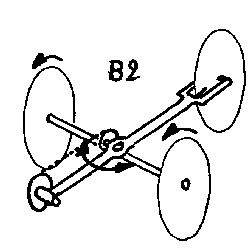
Comment:Fifth wheel steering
B2: Simple to construct with a tilting bottom bracket. Not very resistant versus tilting. With a fixed Bottom bracket complicated construction with at least two joints and a separately ran pinion.
Two front wheels, rear wheel steering, rear wheel drive:
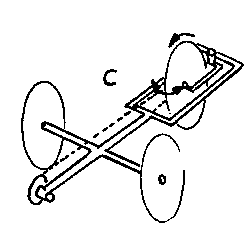
Comment:
C: Complicated construction with one intermediate shaft. Kardan joint and tilting chain, for scientists only...
Two front wheels, rear wheel steering, front wheel drive:
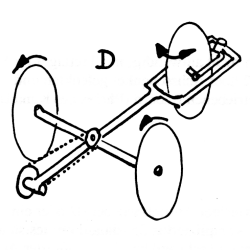
Comment:
D: Popular in the USA (racing vehicles) due to the narrow construction (front wheels do not tilt).
The rear wheel pivot should be behind the rear wheel. A steering damping is useful as it is the case for most rear wheel steered vehicles. An example for a damping is a hydraulic system or a wire rolled around the steering axis. The rider should sit as far in the front of the vehicle as possible. In general, all rear wheel steered vehicles tend to oversteer, i.e. the vehicle runs into a curve that is narrower than the corresponding steering angle. A directional stability can be only achieved with additional technical parts like steering dampers.
Two rear wheels, front wheel steering, rear wheel drive:
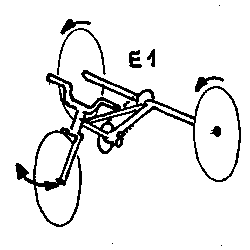
Comment:
E1: Realisation is simple, center of gravity is far in the rear. Otherwise, it is tilt sensitive. Differential drive for narrow turns. Disadvantage: if one wheel has no contact to the ground, there is no propulsion. Alternatively, only the left rear wheel is driven (in most countries) via intermediate shaft. A narrow turning circle can only be achieved in right hand turns. A third alternative is a shaft with two freewheels. Disadvantage: large turning circle.
Comment: In case of vehicles with driven axles (B1, B2, E1, E2), the sketches show a double-face drive. Nevertheless, there are three alternatives as mentioned above (E1).
Two rear wheels, front wheel steering, rear wheel drive:
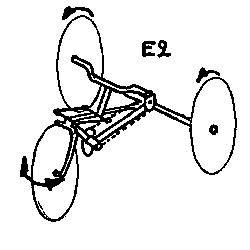
Comment:
E2: for example. Velo V, indirect steering with above seat steering, transmission by double- or single bar or by chain. A below seat steering is also possible to realise, for example 3R6.
Two rear wheels, front wheel steering, front wheel drive:
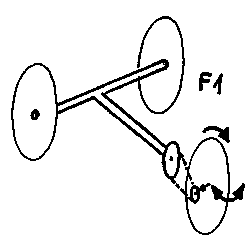
Comment:
F1: For example Caferacer by Marinus Meijers, a pure racing vehicle. An unconventional drive is necessary (a joint getween gear and front wheel). Description in "Human Power, 6,2-87) The very short chain drive is poorly applicable for a dérallieur, because of the inclination of the chain.
Two rear wheels, front wheel steering, front wheel drive:
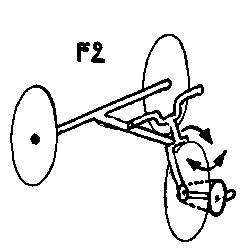
Comment:
F2: Tricycle by Eggert Bülk from Hamburg, only little steering reaction (when pedaling) if the fork angle is low. Easily to cycle by freehand. Simple to construct.
Two rear wheels, rear wheel steering, front wheel drive:
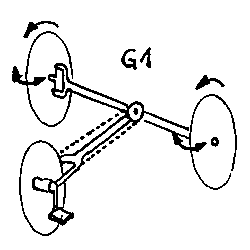
Comment:
G1: Rather complicated, the bottom bracket is in the front wheel and steered/driven by two steering stub axles (Phebis from Canada).
Two rear wheels, rear wheel steering, rear wheel drive:
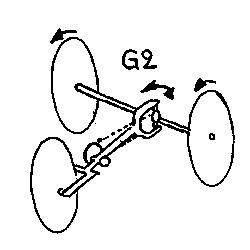
Comment:
G2: Drive is difficult to realise similar to B2. Alternatively a very complicated particular part with fixed gear and swivelling axis.
Two rear wheels, rear wheel steering, front wheel drive:
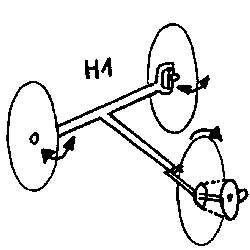
Comment:
H1: Relatively simple to construct. Steering performed for example by wires on a small steering wheel. This kind of vehicle was sold some years long by Alex Meyer from Cologne. An good vehicle was made by Helmut Kißling presented at a German youth research award. A steering via bars and levers or handlebars could be realised.
Two rear wheels, rear wheel steering, front wheel drive:
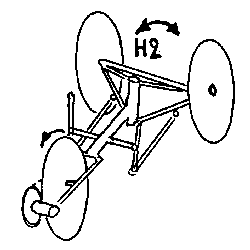
Comment:
H2: Simple to construct, no custom made parts. If the steering axis is inclined the the back side of the vehicle, the vehicle behaves a little bit like a tilting tricycle. The roadability is not very good especially in narrow turns. The rear wheel on the inner side can lift suddenly. Examples: Forelle (W.Stiffel) and Jouta. I do not recommend the use of these vehicles for sportive purposes.
Two front wheels, front wheel steering, rear wheel drive:
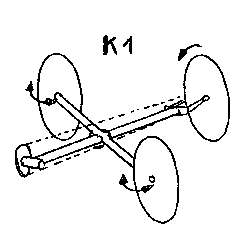
Comment:
K1: Tilting tricycle, the three wheels and the rider are tilting. Complicated technique, because the inclination does not only depend on the steering angle but also from the speed. An elegant version of this vehicle is made by Frank Schliewert gebaut.
Two rear wheels, rear wheel steering, front wheel drive:
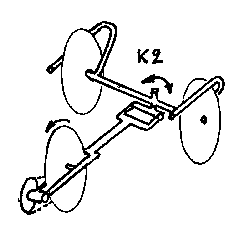
Comment:
K2: rear wheels stay vertical. Front part of the vehicles with the rider on it is tilting into the curve. There are several alternatives, one of them was realised by Röbi Stolz from Switzerland. The rear axle is fixed on two joints and is steered by tipping levers. The higher the lever is risen, the stronger is the tilting effect. In case the rear joint is almost vertical, this corresponds to the tricycle construction H2.
Two front wheels, front wheel drive, front and rear wheel drive:
 |
Comment:
L: I saw a Russian guy with such a vehicle. All the three wheels are driven, suspended and performed by hydraulic brakes. Both front wheels are steered. By sure a good vehicle for winter time. The arrow shows the direction of motion, the tangential arrows the wheels that are driven. The double arrows show the steered wheels / axles.
Werner Stiffel